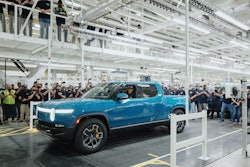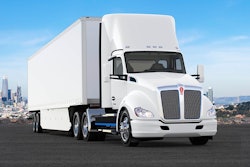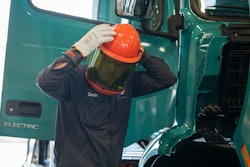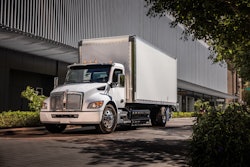Electrification of the U.S. commercial vehicle market is imminent as both incumbent OEMs and EV specialists are introducing electric trucks.
"The electrification wave that is currently swathing over the globe hit passenger cars first," said Roland Berger Senior Partner Dr. Wilfried Aulbur, noting that OEMs have felt the pressure to combat greenhouse gas emissions across entire product portfolios. "We are seeing some of the non-traditional players that are also betting on a future that is predominantly electric."
Aulbur was featured as part of FTR's virtual State of Equipment series this week.
Regulations are pushing electrification as California became the first state to introduce zero-emission truck sales targets, and other states might follow, motivated by Biden's federal GHG reduction targets.
"Typically what we see is that Section 177 states (states that have adopted California's vehicle standards) follow California," Aulbur said, "and it's watched quietly carefully globally."
Federal and regional policies are favorable to electric commercial vehicles and have been strengthened by the Biden Administration. Biden's Clean Energy Plan includes a carbon-neutral electricity grid by 2035 and national net zero GHG emissions by 2050; heavy federal investment in advanced energy technologies; ambitious targets for clean hydrogen cost improvements; and $9.5 billion in overall funding to decrease costs, with $8 billion for four clean hydrogen hubs in Senate's infrastructure bill.
Large fleets, especially in end-consumer facing industries, are committing to sustainability targets with FedEx pledging to go fully electric by 2030; Amazon targeting 50% zero carbon shipments by 2030 and UPS seeking to lower ground emissions by 12% by 2025.
"There's a powerful case, a powerful movement, that is moving toward electrification," Aulbur, said, noting the strong correlation between the location of low income housing and trucking depots. "This means that low income people are exposed much more than others to emissions – to things that harm their overall wellbeing. As you electrify there is a significant social component."
 Hear more about the current landscape of electric trucks and how fleets can adapt on this week's 10-44 webisode in the video above.
Hear more about the current landscape of electric trucks and how fleets can adapt on this week's 10-44 webisode in the video above.
Battery pack pricing for commercial vehicles have dropped to about $150 per kWh since 2020, and Aulbur projects cost to fall to about $100 per kWh by 2030. Total cost of ownership (TCO) is often cited as the most critical business case for battery electrics. Aulbur expects battery costs to further decline in coming years. Electric vehicle maintenance costs are projected at about 40% below combustion engine units, and incentives support early adoption in some states.
Niki Okuk, alternative fuels program manager with clean emissions non-profit Calstart, said a good rule of thumb for the initial purchase of an electric truck is that it will cost about twice as much as a diesel-powered truck without incentives. However, she said most early adopter fleets have found that the cost is offset within the first three years of ownership based on fuel and maintenance cost savings.
The market will evolve in stages, Aulbur predicted: Early adoption driven by green image and incentives, and TCO-driven growth after 2025. This year through 2025, Aulbur noted OEMs will launch small scale production with adoption largely driven by incentives and green fleet image.
"The early adopters are jumping on the bandwagon over the next three to four years," he said. "That's happening as we speak."
After 2025, when OEMs scale up production, Aulbur said BEVs will reach cost parity to diesel for selected use cases (medium-duty distribution trucks, school buses, etc.), and incentives will largely phase out while regulations in selected states support adoption.
By 2030 fuel cell technology provides a viable solution to decarbonize heavy-duty long-haul transportation and decline of clean hydrogen production cost (increasing availability of cheap renewable energy) and lower fuel cell technology cost leads to cost parity with diesel.
EV penetration rates are projected to reach 36% in medium-duty and 12% in heavy-duty by 2030. Declining battery pack prices are a key adoption driver, Aulbur said. Market growth, however, will differ by region as electricity prices vary greatly across the U.S.
Fleet electrification brings challenges for local grid reliability, Aulbur said, but capacity issues at a local level can be managed by pursuing proactive infrastructure build out or engaging in managed charging efforts to shift incremental EV load into off-peak periods.
"Once you apply managed charging, it just isn't a challenge at all," he said.
Okuk said one big change for fleets when it comes to buying electric trucks is that the purchasing process shouldn't start with the purchase of the truck. She said fleets should be figuring out the infrastructure with how they will charge the trucks before actually buying the trucks.
"Fleets are having to take a step back and really get to know their utilities and try to understand better their duty cycles and what they're going to need for charging," she said.
Okuk added that some utilities are even working with fleets to install separate meters for EV chargers and offering a special rate on the electricity used by those chargers.
Hydrogen as a long haul player
Much like batteries, declining technology cost – especially for fuel cell stacks and hydrogen tanks – are a prerequisite for growth of the fuel cell truck market, but Aulbur said he expects the fuel cell system to see significant cost decline once volumes increase from prototype quantities to small scale production
Despite its higher per unit cost of production, small hub-based (onsite) production is likely to be the initial source for supplying green hydrogen. With larger scale production and technology improvements in renewable generation and electrolyzers, by 2030, green hydrogen can be available in the $7- $9/kg range. Prices below $5/kg are expected after 2030, Aulbur forecast.
Aulbur expects growth of the fuel cell truck and bus market in North America to accelerate toward the end of the decade, reaching 30,000 units by 2030. Adoption will primarily be TCO driven and expected to develop locally where favorable conditions meet with higher diesel prices.
Okuk said she sees battery-electric as the breakaway player when it comes to emissions-saving truck technology, but she said to meet the future goals of emissions reduction, it will take a variety of technologies, including electric, hydrogen, natural gas and biodiesel.
"Generally speaking, lots of folks have said that we're going to probably need some mix of all of these alternative fuels in order to get to our very ambitious emissions reduction goals," she said. "So, I wouldn't say anything is off the table at this point because we're going to need all hands on deck to get where we're going."
Fleets, infrastructure players and utilities need to prepare for the operational roll-out of electric trucks, Aulbur noted, adding that fleets need to start early with trials to collect experience. Suitable use cases and lanes that can go electric need to be determined.
Charging players and utilities need to be involved early by fleets and OEMs to develop suitable infrastructure solutions, he said, while utilities need to evaluate necessary modifications to their power grid to support EV adoption.
What does the future hold for electric and other alternative fuel trucks? Check out the video above.











